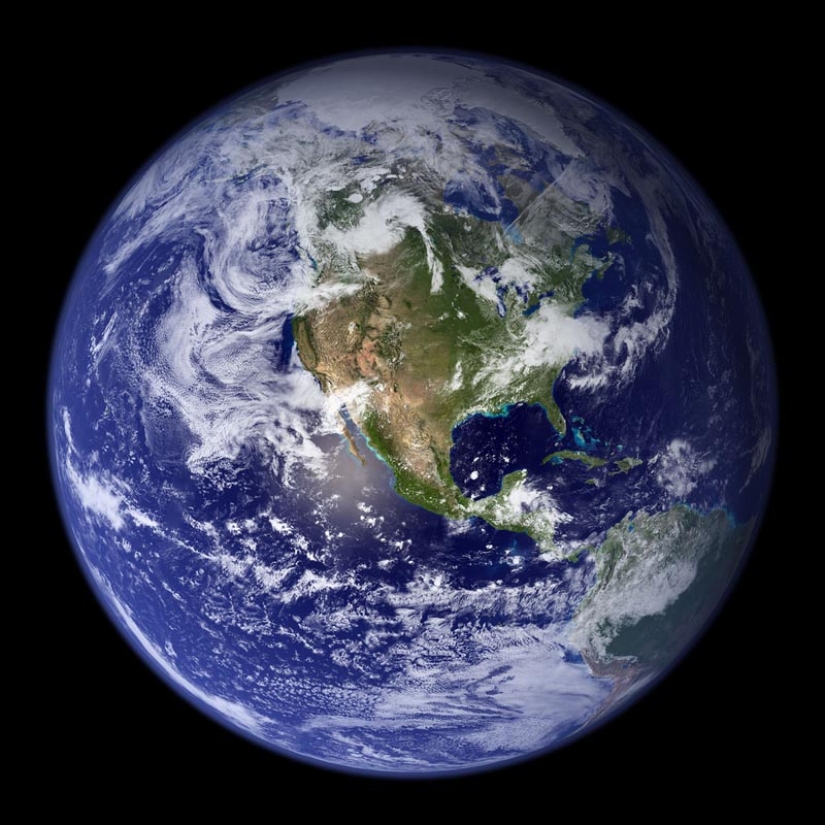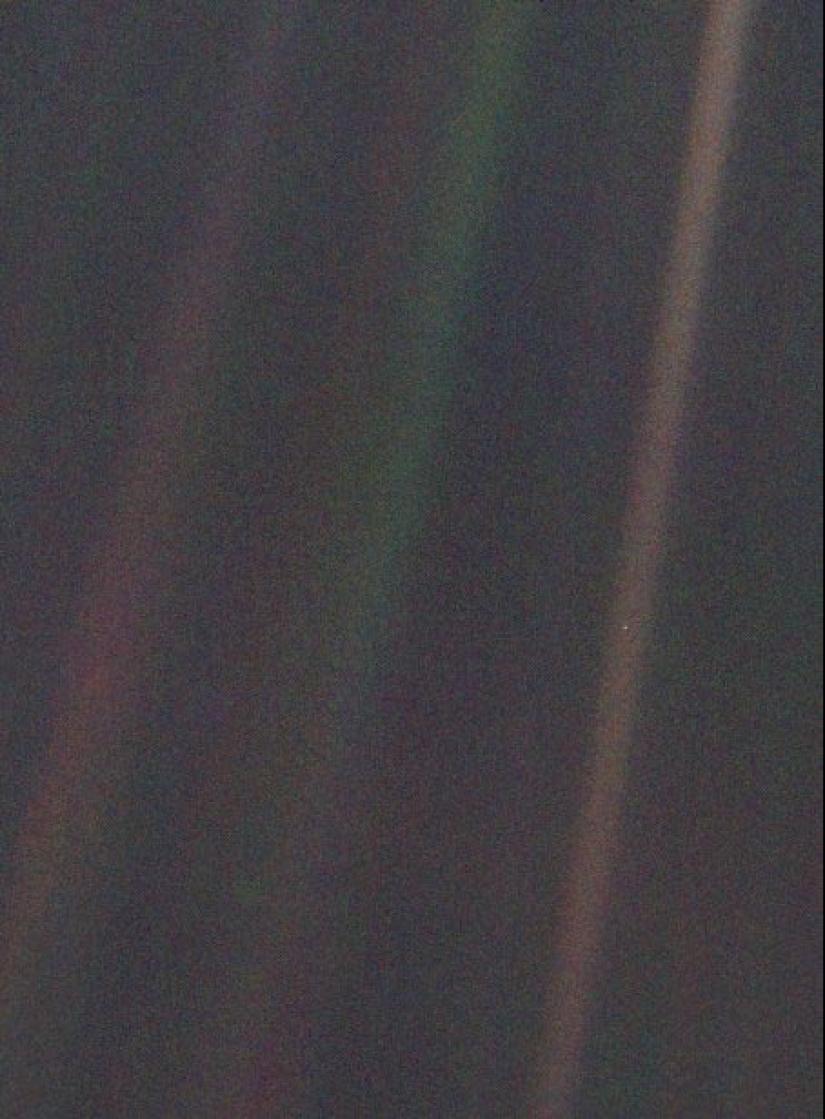The Most Famous Photographs of Earth from Space
Categories: Space
By Pictolic https://pictolic.com/article/the-most-famous-photographs-of-earth-from-space.htmlOur planet from space is an amazing sight, beautiful and inspiring. Let's hope that one day more people will have the opportunity to see our home from space for themselves. In the meantime, enjoy these ten breathtaking views of Earth from NASA. These are the most famous photographs of Earth from space.

 This stunning image, called "blue marble," is the most detailed color image of the entire Earth taken before 2002. Using a collection of satellite images, scientists and visualizers stitched together months of observations of the land, oceans, sea ice, and clouds into a seamless, true-color mosaic. It is one of the most widely known and widely used photographs of Earth.
This stunning image, called "blue marble," is the most detailed color image of the entire Earth taken before 2002. Using a collection of satellite images, scientists and visualizers stitched together months of observations of the land, oceans, sea ice, and clouds into a seamless, true-color mosaic. It is one of the most widely known and widely used photographs of Earth.

Pale Blue Dot. This image of Earth, called the Pale Blue Dot, is part of the first ever “portrait” of the solar system taken by the Voyajer 1 spacecraft. The spacecraft took a total of 60 images for a mosaic of the solar system from a distance of more than 6 billion kilometers from Earth. From this distance, Earth is a mere dot of light, 0.12 pixels in size.
 View of Earth from the Moon. The next famous photo is the incredible image of Earth captured by Apollo 11 during its mission in July 1969. The first lunar mission launched on July 16, 1969 and returned safely to Earth on July 24, 1969. The three-man crew on board consisted of Neil A. Armstrong, Michael Collins, and Edwin Aldrin Jr.
View of Earth from the Moon. The next famous photo is the incredible image of Earth captured by Apollo 11 during its mission in July 1969. The first lunar mission launched on July 16, 1969 and returned safely to Earth on July 24, 1969. The three-man crew on board consisted of Neil A. Armstrong, Michael Collins, and Edwin Aldrin Jr.

First picture of Earth and Moon in one frame. This picture of a crescent-shaped Earth and Moon is the first of its kind ever taken by a spacecraft. Taken on September 18, 1977, by Voyager 1 from a distance of 11.66 million kilometers from Earth. East Asia, the western Pacific Ocean, and part of the Arctic are visible.
 Earth Divider. These two images were taken during the Apollo 11 mission. They show the Earth Divider, a curved line with a diameter approximately equal to the diameter of the Earth. The divider passes through any point on the Earth's surface twice a day, once at sunrise and once at sunset, except at the polar regions, where it does so much less frequently.
Earth Divider. These two images were taken during the Apollo 11 mission. They show the Earth Divider, a curved line with a diameter approximately equal to the diameter of the Earth. The divider passes through any point on the Earth's surface twice a day, once at sunrise and once at sunset, except at the polar regions, where it does so much less frequently.
 Earth and the Moon. Viewed from Mars. This is the first image of Earth ever taken from another planet, and it actually shows our home as a planetary disk.
Earth and the Moon. Viewed from Mars. This is the first image of Earth ever taken from another planet, and it actually shows our home as a planetary disk.
 Earth from the dark side of the Moon. Apollo 16 took this picture with a Hasselblad camera. Much of the landscape seen here is never visible from Earth, as it is the "dark side" of the Moon. Apollo 16 launched on April 16, 1972, and landed on the Moon on April 20. The mission was commanded by John Young.
Earth from the dark side of the Moon. Apollo 16 took this picture with a Hasselblad camera. Much of the landscape seen here is never visible from Earth, as it is the "dark side" of the Moon. Apollo 16 launched on April 16, 1972, and landed on the Moon on April 20. The mission was commanded by John Young.
 Apollo 17. An astronaut plants a flag on the lunar surface with Earth in the background. One of the most famous photographs, it has caused much controversy regarding its origin. A widely accepted version is that the moon landing never happened, and the photo was taken in a staged studio on Earth.
Apollo 17. An astronaut plants a flag on the lunar surface with Earth in the background. One of the most famous photographs, it has caused much controversy regarding its origin. A widely accepted version is that the moon landing never happened, and the photo was taken in a staged studio on Earth.
 Earth on the lunar horizon. This photograph of Earth on the lunar horizon was taken during the Apollo 15 mission, which launched on July 26, 1971.
Earth on the lunar horizon. This photograph of Earth on the lunar horizon was taken during the Apollo 15 mission, which launched on July 26, 1971.
 Blue Planet. Earth from space. The most striking feature of our planet is water. In both liquid and frozen form, it covers 75% of the Earth's surface.
Blue Planet. Earth from space. The most striking feature of our planet is water. In both liquid and frozen form, it covers 75% of the Earth's surface.


Recent articles

Most of us think that the color of the eggshell does not play any role and it is possible not to pay attention. But it's not and ...

The more we rely on technology, the more potential power hackers gain over us. It doesn't matter if their goal is to help or cause ...

Creating a good portrait is one of the most difficult tasks for any photographer. In order to make a really natural and memorable ...